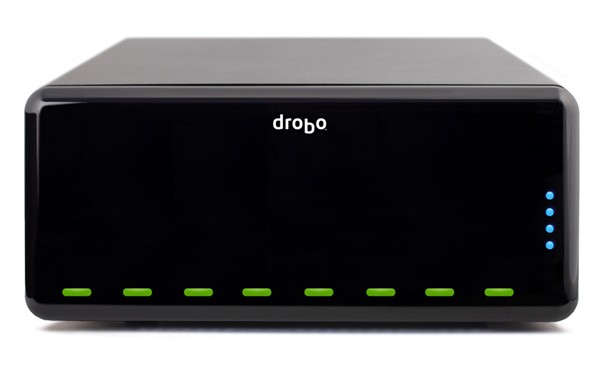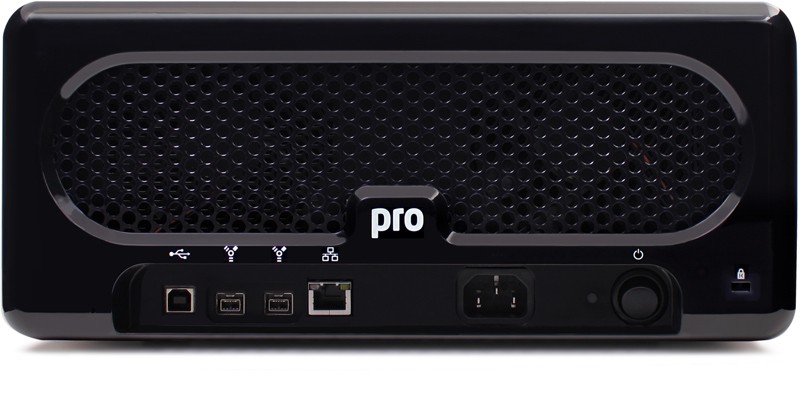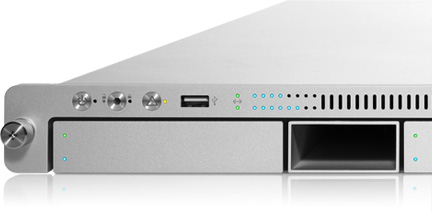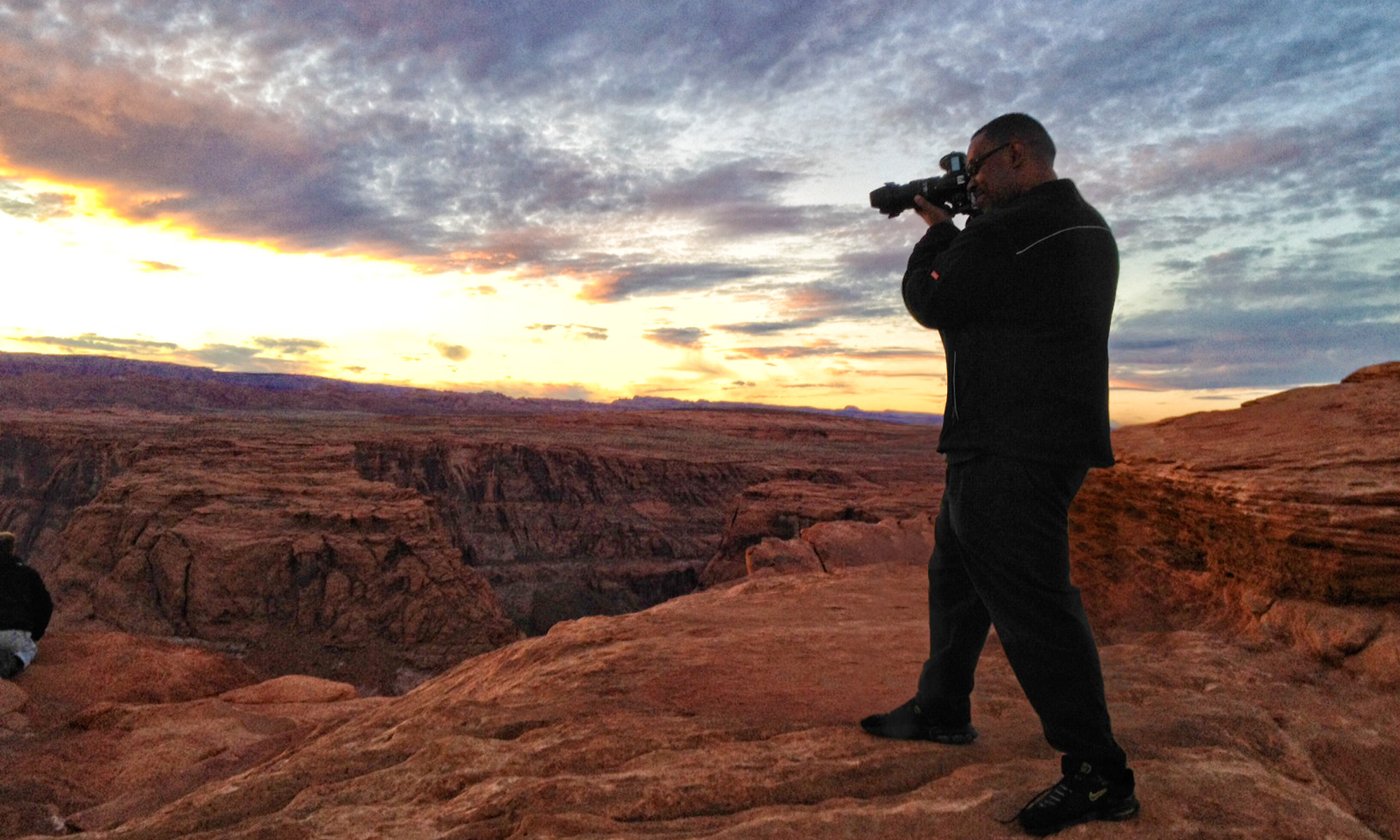
If you’ve had your heart set on serving up some serious amounts of data and doing it really fast, you’ll be interested in two new products that were announced today. First off, the folks at Data Robotics introduced a new model called DroboPro. This new 8 bay beast can be configured with anywhere from 1 to 8 hard drives of any capacity. The largest hard drive available today is 2TB. So now you can realize your 16TB dream. The other addition to the DroboPro is a new connection called iSCSI. It’s a gigabit Ethernet port, but don’t get too excited. It’s not what you’re thinking. It’s not for setting this up as a NAS (network storage device). It’s just to provide super fast transfers to your ONE computer. That being said, there’s nothing to stop you from sharing it over the network by connecting it to a network server (like I do now).
I hear some complain about the “proprietary” BeyondRAID system that DataRobotics has implemented. However, I love the idea of having a single storage device that can grow as my needs grow without having to constantly reformat and start over each time and being able to mix drive sizes. Also if a drive fails, you swap it out and keep going with virtually no downtime.
Of course as I’ve written in the past, no system is perfect and even a Drobo needs backing up because it can’t protect you from data corruption and viruses.
I recently setup a second Drobo on my iTunes server and began the long process of ripping my DVD collection to it to create my own On Demand Apple TV movie system in my home.
The DroboPro will set you back $1,299 for an empty one! For that kind of dough it really should have networking capabilities built-in. (Data Robotics why are you so against this? Paying extra for your SLOW DroboShare product is unacceptable) It’s nice to know that the DroboPro is out there, but currently my two non-pro Drobos are more than enough for me especially as drive capacities keep increasing each year.
Yes there are definitely cheaper solutions out there, but I haven’t seen one yet that does all that Drobo does.
My buddy Scott Kelby has a nice write up today on the DroboPro and how as a pro photographer you can never have to much storage space or be to paranoid about protecting your data. Also check out this first look, er um listen at MacVoices with Data Robotics’ Sr. Director of Products and Markets Mark Fuccio. Checkout Drobo’s website for more details.

Next up, Apple Serves up a New Xserve

The rumors were true and Apple did release a new Xserve based on the intel Xeon Nehalem processors. What does that mean? About twice the performance! Although I’ve always dreamed of owning an Xserve, it would be overkill for my simple serving needs. I’m still on a Power Mac G5 (with Drobo) as my Mac OS X Server and it’s rock solid. However, if you need to serve up large amounts of data to a workgroup or company really fast, then you should definitely check out the Xserve. It comes preloaded with Mac OS X Leopard Server is rack mountable and serves both Mac and Windows clients. This new model is also more energy efficient.


Terry
The iSCSI feature does allow you to share the data. What it does is take the SCSI command set and encapsulate it in IP packets. This means your DroboPro would appear like locally attached storage if you deign. It also means that DroboPro would make good remote storage boxes for satellite offices.
Adding iSCSI turns the DroboPro into a NAS/SAN device unless Data Robotics has somehow artificially limited it’s capabilities.
In your typical iSCSI box you can say take 8 drives and then carve them into LUNS (similiar to partitions in a way) . These LUNS can be assigned to different Server/Workstation. iSCSI brings a lot of flexibility potential if the admin software is solid. We’ll see what Data Robotics has in the way of management software when this thing ships.
hmurchison,
Sadly, Data Robotics didn’t implement it as a stand alone NAS. It must be connected to a host/server computer:
http://www.drobo.com/resources/iscsi.php
“t must be connected to a host/server computer:”
Not exactly. There are two basic kinds of networked storage – SAN and NAS. NAS is generally what home users think of as networked storage – it acts like a shared server, only the OS is built-in and allows configuration either via a command line or web page usually.
SAN is generally used by higher-end users. SANs are used to allow a disk to appear to the host operating system as a local disk via the iSCS protocol. They don’t have to be directly attached to the host system – you can put them on your LAN. You can also share the overall device but to do so you carve out exclusive areas (LUNS or Logical Units) that are dedicated to a single host. So if you have 3 TB of disk, you could carve out 3 LUNS of 1 TB each, have 3 host systems each attach to the unit, and each would use their own LUN. Normally, you can’t share the LUN with another system unless you have an OS on each host that can handle this (like a VMWare ESX server).
At these prices, and with features like rack-mount, the new Drobo is clearly aimed at the higher-end user, and for the most part those users generally implement SANs, not NAS. I doubt Data Robotics saw much need on this unit for NAS capability. NAS tends to be slower because of the overhead of the file sharing protocol, which is much greater than the iSCSI overhead (which is very minimal). Still, if you are only going to hook up to a single system, you’d be better of just hooking up with FireWire, which is a lot faster. The only reason to use iSCSI is to use more than one host device and carve up the space, you don’t have any other connections available, or if you simply need the storage to be far away from the host.
A single storage device that can scale with me is what the doctor ordered! My only recommend is to add iSCSI so that your DroboPro can be a NAS or SAN device.
I will not buy a drobo until it is 100% gigabyte network combatiabble.